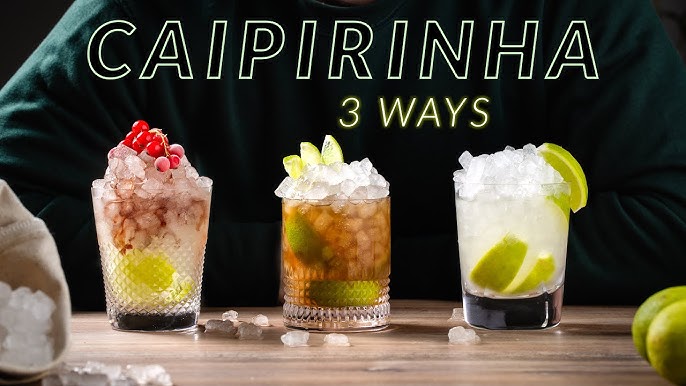Caipirinha Recipe: If you’ve ever been to Brazil or a Brazilian-themed bar, chances are you’ve come across the Caipirinha—a refreshing, citrusy cocktail that’s simple yet incredibly flavorful. This Brazilian national drink is made from cachaça, limes, sugar, and ice, offering a perfect balance of sweetness and tartness.
The origins of the Caipirinha date back to the early 20th century in Brazil, originally crafted as a medicinal drink. Over time, it evolved into one of the most iconic cocktails, enjoyed worldwide for its bold and refreshing taste.
In this guide, we’ll break down everything you need to know about making a perfect Caipirinha at home, from choosing the best ingredients to mixing it just right.
Ingredients Needed
A great Caipirinha relies on just a few simple ingredients.
Essential Ingredients:
- Cachaça (2 oz / 60 ml) – A Brazilian sugarcane spirit, similar to rum but with a more robust flavor.
- Fresh lime (1 whole lime) – Provides the signature tangy taste.
- Granulated sugar (2 teaspoons) – Balances the acidity of the lime.
- Ice cubes or crushed ice – Helps to chill and dilute the drink slightly for a smooth taste.
Alternative Ingredients (for variations):
- Brown sugar – Adds a deeper caramel-like sweetness.
- Honey or simple syrup – For a smoother, less grainy texture.
- Different citrus fruits – Try lemons, tangerines, or passionfruit for a twist.
Tools Required
Making a Caipirinha doesn’t require fancy bar tools, but having the right equipment makes the process smoother.
Must-Have Tools:
- Muddler – Helps extract lime juice and essential oils from the peel.
- Short glass (Old Fashioned Glass) – The traditional serving glass.
- Bar spoon or stirrer – To mix the ingredients properly.
Substitutes for Specialized Tools:
- Wooden spoon – Can be used instead of a muddler.
- Regular knife and spoon – If you don’t have a citrus muddler, a spoon can work.
Step-by-Step Instructions
Step 1: Choosing the Right Limes
- Pick fresh, juicy limes with thin skin; they have more juice and less bitterness.
- Roll the lime on a hard surface before cutting—it helps release more juice.
Step 2: Cutting and Muddling the Limes
- Cut the lime into 8 small wedges (remove the white center to reduce bitterness).
- Place the lime pieces in the glass and muddle gently with sugar.
- Don’t over-muddle; just enough to release the juice without crushing the peel excessively.
Step 3: Adding Sugar for Balance
- Add 2 teaspoons of granulated sugar directly over the muddled limes.
- Stir slightly to mix with the lime juice.
Step 4: Pouring the Cachaça
- Measure and pour 2 ounces (60 ml) of cachaça over the lime and sugar mix.
- Let it sit for a few seconds so the flavors start blending.
Step 5: Mixing Everything Properly
- Stir everything well with a spoon to combine flavors.
- The sugar should start dissolving into the lime juice and cachaça.
Step 6: Adding Ice and Final Touches
- Fill the glass with crushed ice (or ice cubes if you prefer).
- Stir again to chill the drink evenly.
- Garnish with a lime wheel or extra lime wedges for presentation.
Tips for the Perfect Caipirinha
- Choose a good cachaça – Aged cachaça adds depth; unaged cachaça gives a fresher taste.
- Use fine or granulated sugar – It dissolves better and blends well.
- Adjust the sugar to your taste – More sugar makes it sweeter; less keeps it tart.
Variations of Caipirinha
Caipiroska (Vodka-based)
- Replace cachaça with vodka for a milder flavor.
Caipiríssima (Rum-based)
- Swap cachaça for white rum for a tropical twist.
Fruit-Infused Caipirinha
- Add strawberries, passionfruit, or mango for extra flavor.
Serving Suggestions
- Serve in a short, sturdy glass with a thick base.
- Garnish with lime wheels or fresh mint for an elegant look.
Food Pairings
Traditional Brazilian Foods:
- Pão de queijo – Brazilian cheese bread.
- Feijoada – A rich black bean and meat stew.
International Pairings:
- Grilled seafood – Complements the citrusy notes.
- Spicy dishes – Balances out heat with refreshing acidity.
Common Mistakes to Avoid
- Over-muddling the lime – This makes the drink bitter.
- Using too much sugar – Can overpower the citrus flavor.
- Skipping the ice – It’s crucial for a properly balanced drink.
Health and Nutrition Facts
- Calories per serving: ~200 kcal
- Sugar content: ~8-10 grams
- Healthier alternative: Use honey or a sugar substitute.
FAQs about Caipirinha Recipe
1. What is the best alcohol for a Caipirinha?
The traditional and best alcohol for a Caipirinha is cachaça, a Brazilian spirit made from fermented sugarcane juice. If you can’t find cachaça, you can substitute with white rum, but it won’t have the same authentic taste.
2. Can I use brown sugar instead of white sugar?
Yes! Brown sugar can add a richer, slightly caramelized flavor to your Caipirinha. However, the classic recipe typically uses white sugar for a cleaner, crisper taste.
3. What’s the best way to muddle the lime?
To extract the most flavor, cut the lime into wedges and gently muddle them with sugar in the bottom of your glass. Avoid over-muddling, as this can release bitterness from the lime peel.
4. Can I make a Caipirinha without alcohol?
Absolutely! You can make a non-alcoholic Caipirinha by replacing cachaça with sparkling water or ginger ale for a refreshing mocktail.
5. What’s the difference between a Caipirinha and a Mojito?
While both are lime-based cocktails, the Caipirinha uses cachaça and no mint, whereas a Mojito is made with rum and includes mint leaves for extra freshness.
6. Can I use other fruits in a Caipirinha?
Yes! You can experiment with strawberries, passion fruit, pineapple, or even mango to create fruity variations of the classic Caipirinha. Just muddle the fruit with sugar before adding cachaça.
7. How can I make my Caipirinha less strong?
To make a lighter Caipirinha, simply add more crushed ice or dilute it with a splash of soda water while still keeping the delicious flavors intact.



